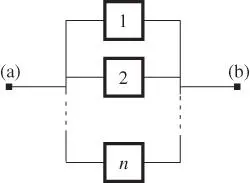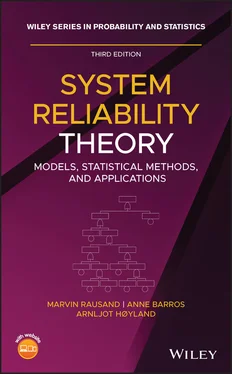The RBD is not a physical layout diagram of the system, but a logic diagram that shows how and when the system function, SF, is up. The sequence of failures is not important, and the RBD in Figure 2.10is therefore equivalent to the RBD in Figure 2.11. The RBD shows the structure of the system with respect to a specified system function, SF. When discussing RBD, we talk about the structure instead of the system. Separate RBDs have to be established for each system function.

Figure 2.11An alternative, and identical, version of the RBD in Figure 2.10.
Arranging several components along a path means connecting them by an AND‐ operation and arranging several components in parallel paths represents and OR‐operation. In essence, a RBD is a graphical representation of a Boolean expression . Boolean expressions are discussed further in Section 4.6. The system function SF in Figure 2.10is seen to be up if block 1 is up AND block 2 OR block 3 is up.
A series structure is functioning if and only if all the  blocks are functioning. This means that the structure fails as soon as one block fails. The RBD of a series structure of
blocks are functioning. This means that the structure fails as soon as one block fails. The RBD of a series structure of  blocks is shown in Figure 2.12. A path is seen to be available between the end points (a) and (b) – and the system is functioning – if and only if all the
blocks is shown in Figure 2.12. A path is seen to be available between the end points (a) and (b) – and the system is functioning – if and only if all the  blocks are functioning. The system function can be represented by the Boolean expression: The series structure is functioning if block 1 AND block 2 AND
blocks are functioning. The system function can be represented by the Boolean expression: The series structure is functioning if block 1 AND block 2 AND  AND block
AND block  are all functioning. As mentioned above, the sequence of the blocks in Figure 2.12is not important, and we might have drawn the RBD with the
are all functioning. As mentioned above, the sequence of the blocks in Figure 2.12is not important, and we might have drawn the RBD with the  blocks in any sequence.
blocks in any sequence.

Figure 2.12RBD for a series structure.
A parallel structure is functioning as long as at least one of its  blocks is able to function. The RBD of a parallel structure is shown in Figure 2.13. For this structure, there are
blocks is able to function. The RBD of a parallel structure is shown in Figure 2.13. For this structure, there are  different paths between the end points (a) and (b). The structure is functioning if any one of these
different paths between the end points (a) and (b). The structure is functioning if any one of these  paths is functioning. This means that the structure is functioning if at least one of the
paths is functioning. This means that the structure is functioning if at least one of the  blocks is functioning. The parallel structure can be represented by the Boolean expression: The parallel structure is functioning if block 1 OR block 2
blocks is functioning. The parallel structure can be represented by the Boolean expression: The parallel structure is functioning if block 1 OR block 2  OR block
OR block  is functioning.
is functioning.

Figure 2.13Parallel structure.
Redundancy is a means to improve the reliability of a structure. Redundancy may be defined as follows:
Definition 2.9 (Redundancy)
The provision of more than one means or parallel paths in a structure for performing a given function such that all means must fail before causing system failure.
The parallel structure in Figure 2.13has redundancy because all the  blocks have to fail to cause the specified system failure, SF. Because
blocks have to fail to cause the specified system failure, SF. Because  blocks have to fail, the system is said to have redundancy of order
blocks have to fail, the system is said to have redundancy of order  .
.
Parallel or redundant paths can be installed for a single block, for a selection of blocks, or for the entire system function, SF.
For hardware, redundancy may be achieved by installing one or more extra hardware items in parallel with the initial item. The redundant items may be identical or diverse. Adding redundancy increases the cost and makes the system more complicated, but if the cost of failure is high, redundancy is often an attractive option.
A  ‐out‐of‐
‐out‐of‐  (
(  oo
oo  ) voted structure is functioning as long as at least
) voted structure is functioning as long as at least  of its
of its  blocks are functioning (
blocks are functioning (  ). Observe that an
). Observe that an  oo
oo  voted structure is a series structure and a 1oo
voted structure is a series structure and a 1oo  structure is a parallel structure.
structure is a parallel structure.
A 2oo3 voted structure is shown in Figure 2.14. Two different diagrams are shown. The diagram to the left is a physical diagram that shows the 2oo3 logic, whereas the RBD to the right is a series–parallel structure. In the RBD, we see that the system is functioning when block 1 AND block 2 are functioning OR block 1 AND block 3 are functioning OR block 2 AND block 3 are functioning. Observe that each block appears in two different places in this RBD. This shows that an RBD is not a physical layout diagram, but a logical graph illustrating the specified function of the system.
Читать дальше


 blocks are functioning. This means that the structure fails as soon as one block fails. The RBD of a series structure of
blocks are functioning. This means that the structure fails as soon as one block fails. The RBD of a series structure of  blocks is shown in Figure 2.12. A path is seen to be available between the end points (a) and (b) – and the system is functioning – if and only if all the
blocks is shown in Figure 2.12. A path is seen to be available between the end points (a) and (b) – and the system is functioning – if and only if all the  blocks are functioning. The system function can be represented by the Boolean expression: The series structure is functioning if block 1 AND block 2 AND
blocks are functioning. The system function can be represented by the Boolean expression: The series structure is functioning if block 1 AND block 2 AND  AND block
AND block  are all functioning. As mentioned above, the sequence of the blocks in Figure 2.12is not important, and we might have drawn the RBD with the
are all functioning. As mentioned above, the sequence of the blocks in Figure 2.12is not important, and we might have drawn the RBD with the  blocks in any sequence.
blocks in any sequence.
 blocks is able to function. The RBD of a parallel structure is shown in Figure 2.13. For this structure, there are
blocks is able to function. The RBD of a parallel structure is shown in Figure 2.13. For this structure, there are  different paths between the end points (a) and (b). The structure is functioning if any one of these
different paths between the end points (a) and (b). The structure is functioning if any one of these  paths is functioning. This means that the structure is functioning if at least one of the
paths is functioning. This means that the structure is functioning if at least one of the  blocks is functioning. The parallel structure can be represented by the Boolean expression: The parallel structure is functioning if block 1 OR block 2
blocks is functioning. The parallel structure can be represented by the Boolean expression: The parallel structure is functioning if block 1 OR block 2  OR block
OR block  is functioning.
is functioning.
 blocks have to fail to cause the specified system failure, SF. Because
blocks have to fail to cause the specified system failure, SF. Because  blocks have to fail, the system is said to have redundancy of order
blocks have to fail, the system is said to have redundancy of order  .
. ‐out‐of‐
‐out‐of‐  (
(  oo
oo  ) voted structure is functioning as long as at least
) voted structure is functioning as long as at least  of its
of its  blocks are functioning (
blocks are functioning (  ). Observe that an
). Observe that an  oo
oo  voted structure is a series structure and a 1oo
voted structure is a series structure and a 1oo  structure is a parallel structure.
structure is a parallel structure.










